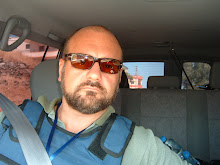 I conducted the security risk assessment in Nicaragua in February 2008. I inspected the Country Office in Managua as well as all field offices and logistic facilities of a worldwide International Organization (Corinto, Puerto Cabezas, Ocotal, Matagalpa, Siuna). A one day boat trip along the Coco River (Waspam) has been conducted in order to verify the navigation security conditions of staff during implementation of field operations in the Northern areas of the country.
I conducted the security risk assessment in Nicaragua in February 2008. I inspected the Country Office in Managua as well as all field offices and logistic facilities of a worldwide International Organization (Corinto, Puerto Cabezas, Ocotal, Matagalpa, Siuna). A one day boat trip along the Coco River (Waspam) has been conducted in order to verify the navigation security conditions of staff during implementation of field operations in the Northern areas of the country.The picture shows (me next to) a gigantic Govt propaganda poster of President Daniel Ortega praising his Populist/Socialist political message in favour of the masses.
Nicaragua, as seen in its regional context, is one of the less dangerous countries compared with its neighbours El Salvador, Honduras and Guatemala. Police coverage is extremely sparse outside of major urban areas, particularly in Nicaragua’s Atlantic coast. Sporadic incidents of highway banditry happen frequently in remote rural areas of north and northwest Nicaragua. In order to reduce the threat of being involved in such criminal event it is recommendable to travel between 6.00 AM and 6.00 PM. Political demonstrations and strikes occur sporadically, are usually limited to urban areas, and occasionally become violent. In the Puerto Cabezas area recently a public protest against local government (Alcaldia) took place. Stones have been launched but the police was able to keep the protest under control.Regarding major organized criminal activities it should be noted that narcotics traffickers often use the Caribbean and Pacific coastal waters. The new luxury houses located in very isolated places show that there is an increment of drug traffic between Colombia and Mexico/US affecting those countries in between.Assaults and armed attacks have been registered in isolated areas, mainly along the route Managua – Puerto Cabezas where overcrowded buses are stopped and travellers robbed.
THREAT ANALYSIS
The greatest area of concern of the internal security is related with several illicit activities conducted by both common and organized criminality. Violent crime in Managua and other cities is increasing, and street crimes are frequent. Pick pocketing and occasional armed robberies occur on crowded buses, at bus stops and in open markets, particularly the large Mercado Oriental, and less frequently at the Huembes market. Gang activity is rising in Managua, though not at levels found in neighbouring Central American countries (El Salvador, Guatemala, etc). Gang violence, including robbery, assault and stabbing, is most frequently encountered in poorer neighbourhoods, including the Ticabus area, but has occurred in the neighbourhoods surrounding major hotels, bus terminals and open-air markets.Street crime and petty theft are a common problem in Puerto Cabezas, along both the Nicaraguan Caribbean coast and route Managua – Puerto Cabezas. Lack of adequate police coverage has resulted in these areas being used by drug traffickers and other criminal elements. Taxi drivers and passengers have been victims of robbery, assault, sexual assault, and even murder. It is advisable, before taking a taxi, to be sure that the cab has a red license plate and that the number is clearly legible. The taxi must be properly labelled with the cooperative (company) name and logo. While riding in a vehicle, windows should be closed, car doors locked and valuables placed out of sight.Crimes of opportunity such as car theft, abduction and muggings are ever present. In essence, the high level of criminality has little or no authority and no recourse to Police action in the rural areas is a serious threat to all visitors to, and agencies in, Nicaragua. As mentioned above, almost in all towns (mainly in the centers) the legality and police enforcement have not been fully restored.
Force Majeure:
Hurricanes present a constant threat to Nicaragua during the rainy season which has seen a penetration within the Caribbean Coast in the Puerto Cabezas area. Nicaragua is subject to Earthquakes as well. The last quake in 1972 has partially destroyed Managua. Since the capital lies in the proximity of the S. Andrea fault the exposition at tremors and earthquakes is relevant.
In the next posts I will analyze some interesting aspects of the difficulties encountered by staff deployed in different field locations. Puerto Cabezas represents the most challenging field site for its exposure to hurricanes and its geographic complexity (located on the shores of Rio Coco, facing the Caribbean Sea).
















No comments:
Post a Comment